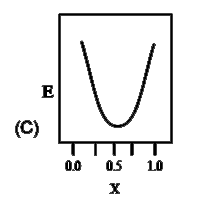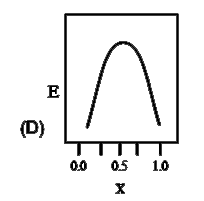Two charge +Q each are placed at the two verticles of an equilateral triangle of side a .The intensity of electric field at the third vertex is
To find the intensity of the electric field at the third vertex of an equilateral triangle with two charges +Q at the other two vertices, we can follow these steps:
1. Understanding the Configuration:
- We have an equilateral triangle with vertices A, B, and C.
- Charges +Q are placed at vertices A and B.
- We need to find the electric field at vertex C due to these two charges.
2. Calculating Electric Field Due to One Charge:
- The electric field E due to a point charge Q at a distance r is given by the formula:
E=kQr2
- Here, the distance r from either charge to vertex C is equal to the side length a of the triangle.
3. Electric Field at Vertex C from Each Charge:
- The electric field at vertex C due to charge at A (denote as EA) is:
EA=kQa2
- The electric field at vertex C due to charge at B (denote as EB) is:
EB=kQa2
4. Direction of Electric Fields:
- The electric field EA points away from charge A towards C.
- The electric field EB points away from charge B towards C.
- The angle between EA and EB is 60∘ because of the geometry of the equilateral triangle.
5. Calculating the Resultant Electric Field:
- To find the net electric field Enet at vertex C, we use the vector addition of EA and EB:
Enet=√E2A+E2B+2EAEBcos(60∘)
- Since EA=EB=kQa2 and cos(60∘)=12:
Enet=√(kQa2)2+(kQa2)2+2(kQa2)(kQa2)(12)
- Simplifying this:
Enet=√2(kQa2)2+(kQa2)2
=√3(kQa2)2
=kQ√3a2
6. Final Expression:
- Substituting k=14πϵ0:
Enet=√3Q4πϵ0a2
Final Answer:
The intensity of the electric field at the third vertex is:
Enet=√3Q4πϵ0a2
- We have an equilateral triangle with vertices A, B, and C.
- Charges +Q are placed at vertices A and B.
- We need to find the electric field at vertex C due to these two charges.
- The electric field E due to a point charge Q at a distance r is given by the formula:
E=kQr2
- Here, the distance r from either charge to vertex C is equal to the side length a of the triangle.
- The electric field at vertex C due to charge at A (denote as EA) is:
EA=kQa2
- The electric field at vertex C due to charge at B (denote as EB) is:
EB=kQa2
- The electric field EA points away from charge A towards C.
- The electric field EB points away from charge B towards C.
- The angle between EA and EB is 60∘ because of the geometry of the equilateral triangle.
- To find the net electric field Enet at vertex C, we use the vector addition of EA and EB:
Enet=√E2A+E2B+2EAEBcos(60∘)
- Since EA=EB=kQa2 and cos(60∘)=12:
Enet=√(kQa2)2+(kQa2)2+2(kQa2)(kQa2)(12)
- Simplifying this:
Enet=√2(kQa2)2+(kQa2)2
=√3(kQa2)2
=kQ√3a2
- Substituting k=14πϵ0:
Enet=√3Q4πϵ0a2
The intensity of the electric field at the third vertex is:
Enet=√3Q4πϵ0a2
Topper's Solved these Questions
- ELECTROSTATICS AND GAUSS LAWBook:NARAYNAChapter:ELECTROSTATICS AND GAUSS LAWExercise:C.U.Q
Explore 133 Videos
- ELECTROSTATICS AND GAUSS LAWBook:NARAYNAChapter:ELECTROSTATICS AND GAUSS LAWExercise:Level 1(C.W)
Explore 24 Videos
- ELECTROSTATIC POTENTIAL AND CAPACITANCEBook:NARAYNAChapter:ELECTROSTATIC POTENTIAL AND CAPACITANCEExercise:ADDITIONAL PROBLEMS
Explore 14 Videos
- EXPERIMENTAL PHYSICSBook:NARAYNAChapter:EXPERIMENTAL PHYSICSExercise:Comprehension type
Explore 6 Videos
Similar Questions
Two charge +Q,−Q are placed at the two verticels of an equilateral triangle of side 'a'. Then the intensity of electric field at the third vertex is
View SolutionThree identical positive charges Q are arranged at the vertices of an equilateral triangle. The side of the triangle is a. Find the intensity of the field at the vertex of a regular tetrahedron of which the triangle is the base.
View Solution
Knowledge Check
Equal charges q are placed at the vertices A and B of an equilatral triangle ABC of side a. The magnitude of electric field at the point C is
Aq4πε0a2B√2q4πε0a2C√3q4πε0a2Dq2πε0a2A total charge q is divided as q1 and q2 which are kept at two of the vertices of an equilateral triangle of side a. The magnitude of the electric field E at the third vertex of the triangle is to be depicted schematically as a function of x=q1/q. Choose the correct figure.
A B
B C
C D
D
Three point charges q are placed at three vertices of an equilateral triangle of side a. Find magnitude of electric force on any charge due to the other two.
A(√34πε0)(qa)2B(√24πε0)(qa)2C(√34πε0)(q2a)2D(√24πε0)(2qa)2
If two particles each of mass m are placed at the two vertices of an equilateral triangle of side a, then the resultant gravitational force on mass m placed at the third vertex is
View SolutionIf two particles each of mass m are placed at the two vertices of an equilateral triangle of side a, then the resultant gravitational force on mass m placed at the third vertex is
View SolutionTwo balls of mass m each are placed at the two vertices of an equilateral triangle. Another ball of mass 2m is placed at the third vertex of the triangle. Locate the centre of mass of the system.
View SolutionTwo charges each equal to ηq(η−1<√3) are placed at the corners of an equilateral triangle of side a. The electric field at the third corner is E3 where(E0=q/4πε0a2)
View SolutionElectric charges q,q,–2q are placed at the corners of an equilateral triangle ABC of side l. The magnitude of electric dipole moment of the system is
View Solution
